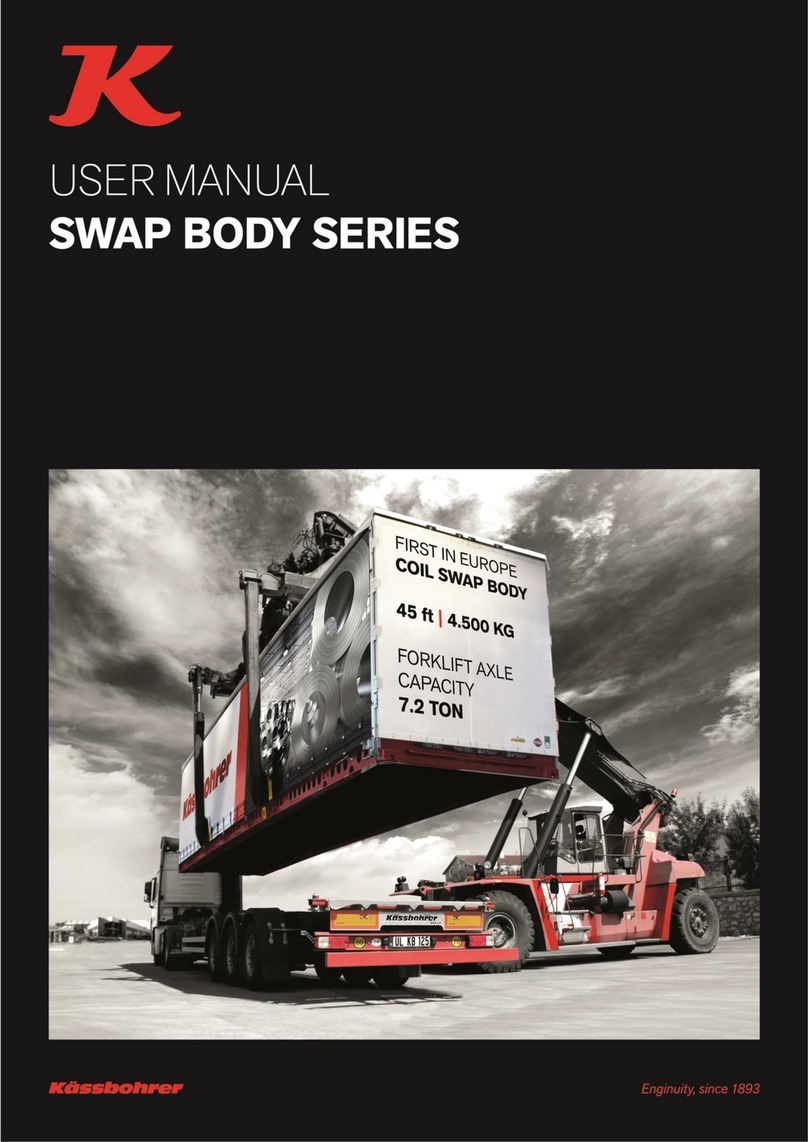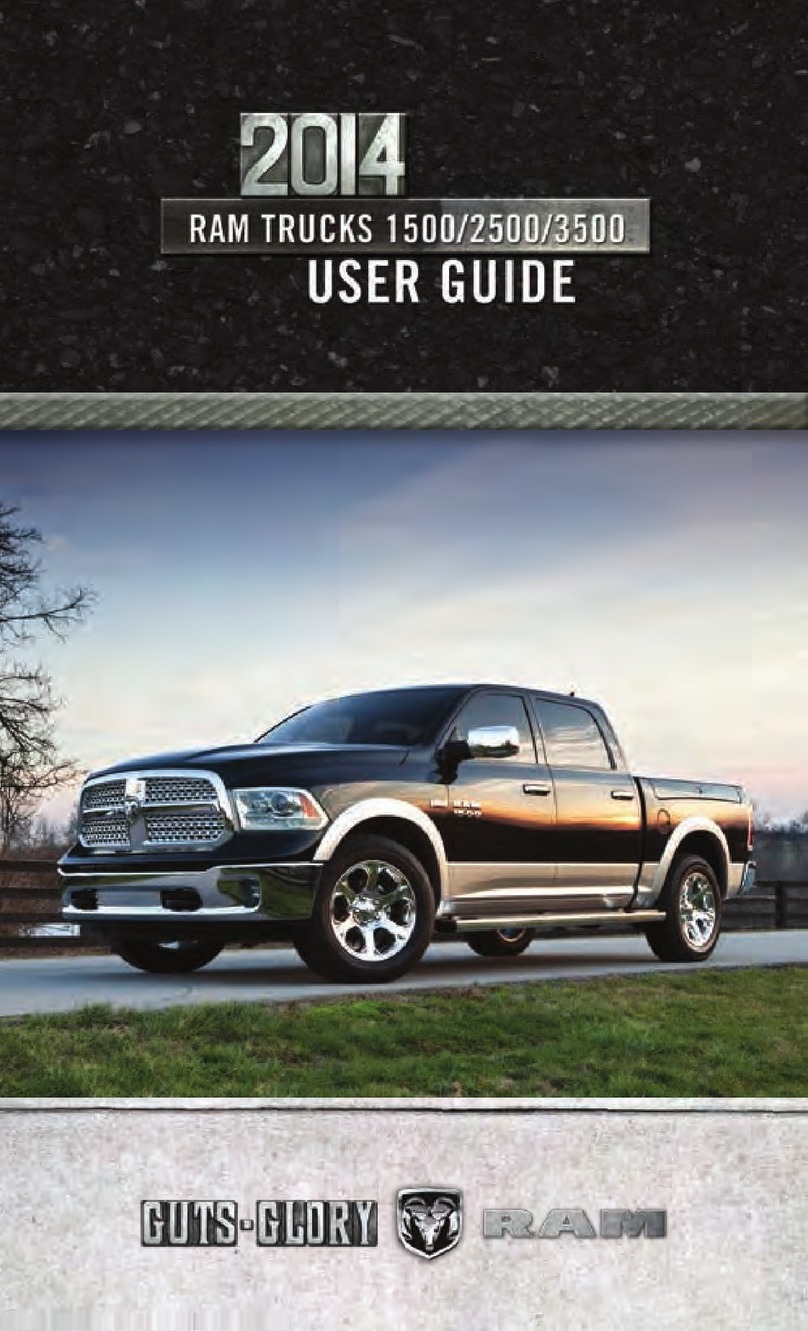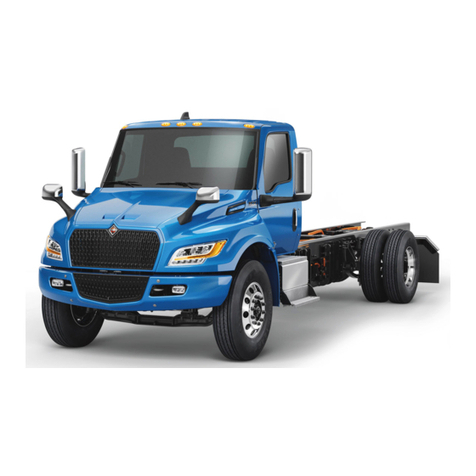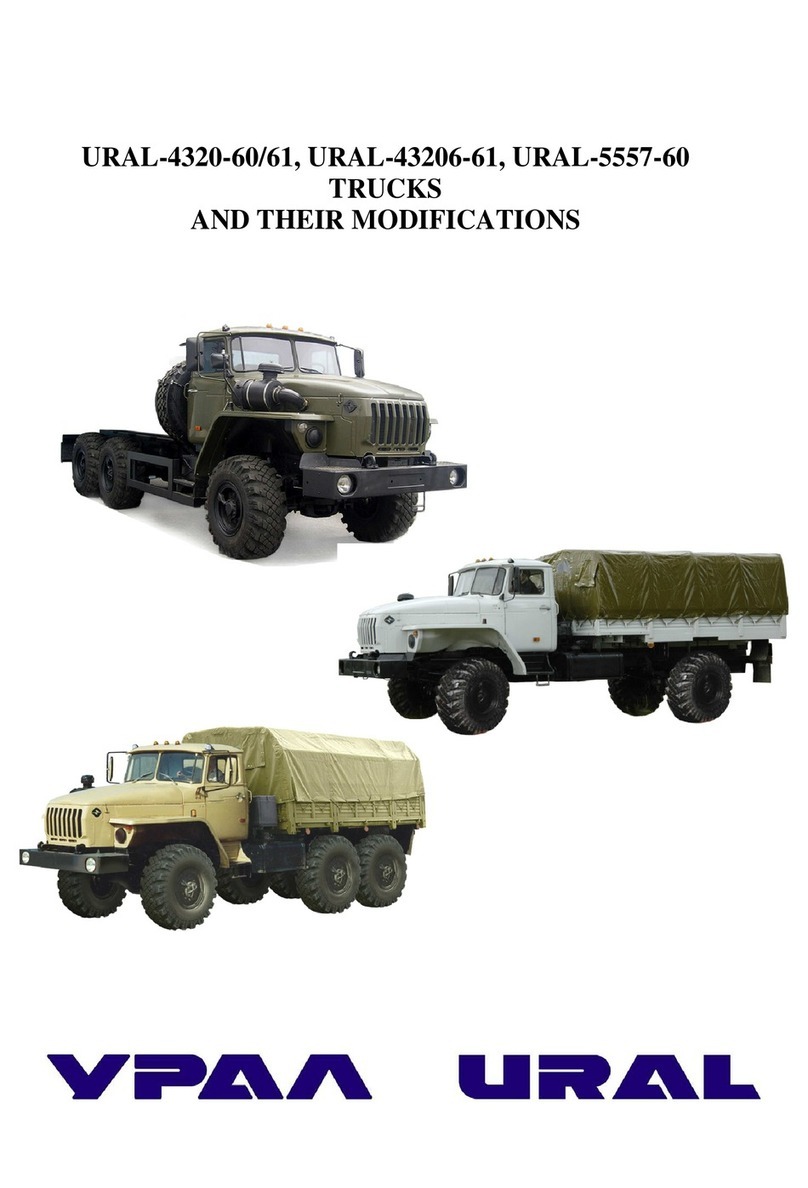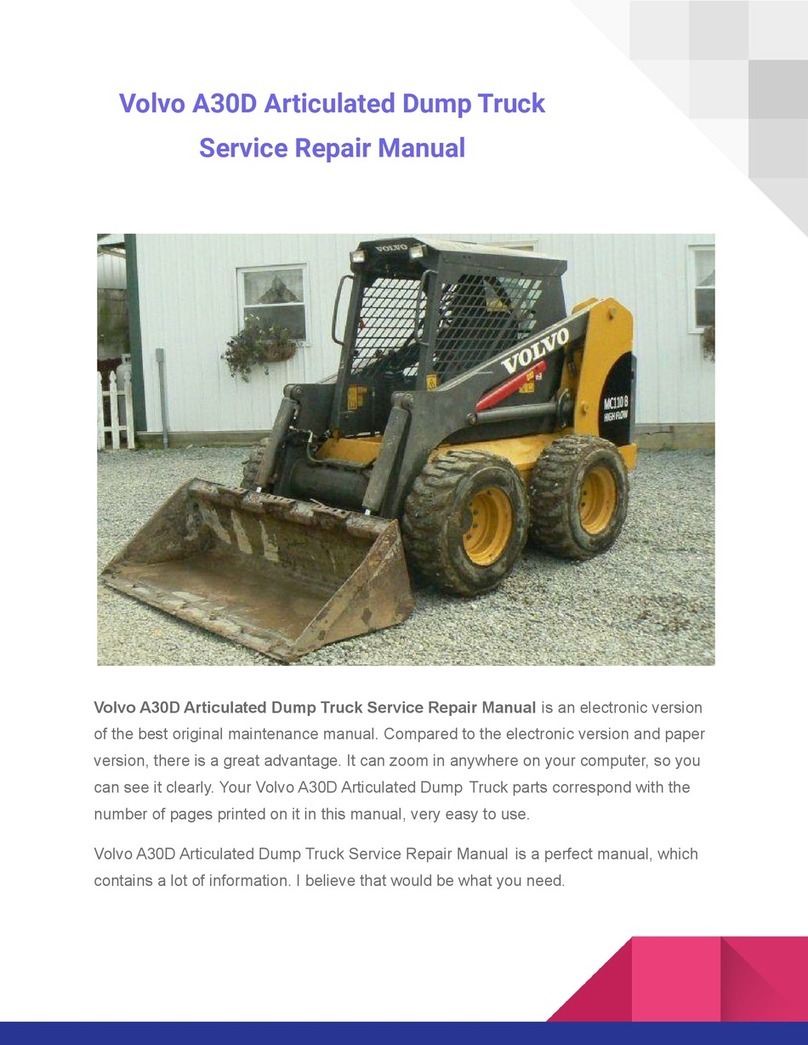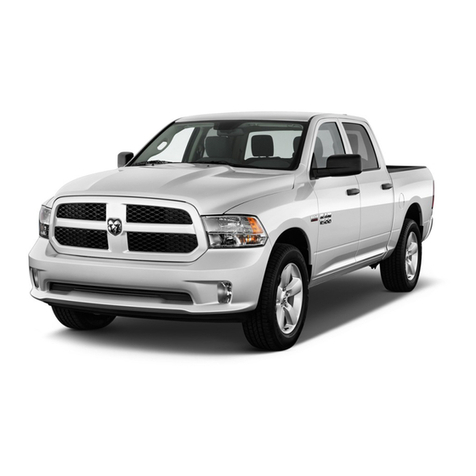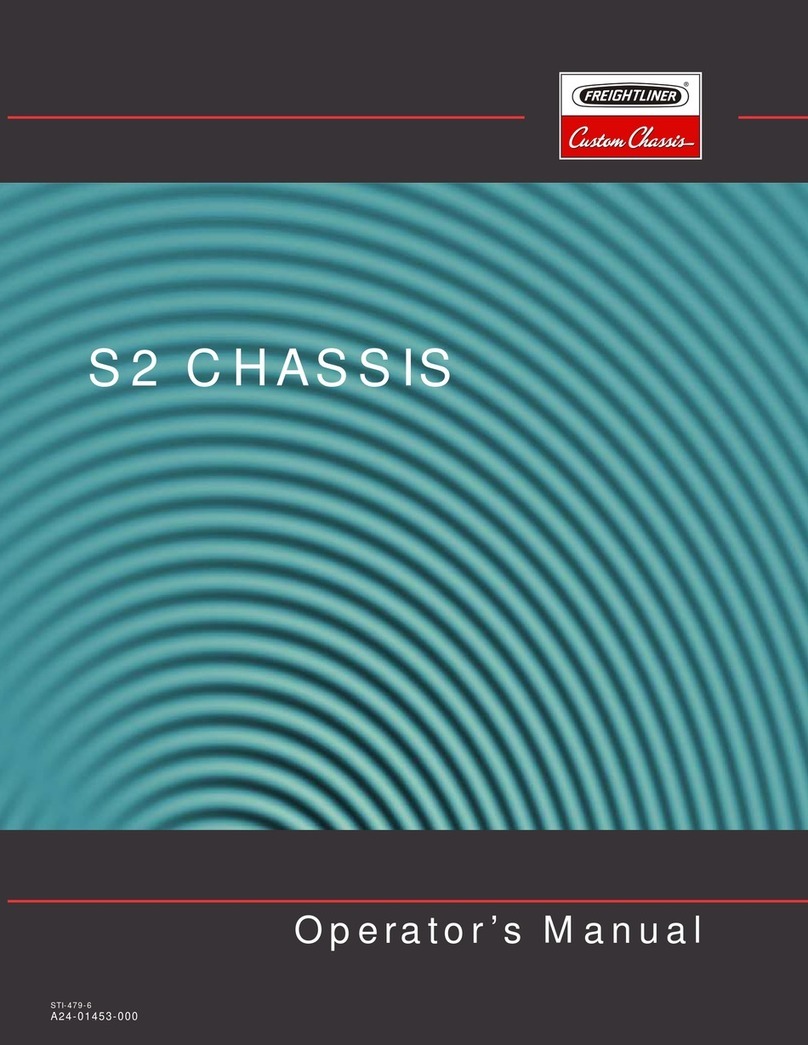Kässbohrer Reefer 2023 Series User manual


IInnddeexx
1. GENERAL INFORMATION AND SAFETY INSTRUCTIONS
1.1. About the User Manual ..............................................................7
1.2. Meanings of Symbols Used in User Manual..............................7
1.3. Terms of Use and Safety Information ........................................8
2. MAIN INFORMATIONS
2.1. Vehicle Identification Plate ........................................................9
2.2. Brake Data Plate.........................................................................9
2.3. VIN (Chassis) Numbers .............................................................9
2.4. Warranty and Responsibility ......................................................9
3. TRAILER RUNNING GEAR AND USAGE INSTRUCTIONS
3.1. Brake System ...........................................................................11
3.1.1. Air Couplings ....................................................................11
3.1.2. Compressed Air Tanks ......................................................14
3.1.3. EBS Socket........................................................................14
3.1.4. Roll Stability Support (RSS).............................................15
3.1.5. PREV (Park Release Emer-gency Valve) .........................15
3.1.6. Brake Chambers ................................................................16
3.2. Suspension System...................................................................18
3.2.1. Manuel Control Lever .......................................................18
3.2.2. Auto Reset.........................................................................19
3.2.3. Electronic Controlled Air Suspension (ECAS).................19
3.2.4. Second Driving Height......................................................19
3.2.5. Manometer (Axle Load Indicator) ....................................20
3.2.6. Smartboard (Info Center) ..................................................20
3.2.7. TailGUARD ......................................................................20
3.3. Electrical System......................................................................21
3.3.1. 15 Pin Socket.....................................................................21
3.3.2. 2x7 Pin Socket...................................................................22
3.4. Light System ............................................................................23
3.5. King Pin ...................................................................................24
3.6. Landing Gear............................................................................24
3.6.1. Front Landing Gear’s Working Principle..........................24
3.6.2. Rear Landing Gear Working Principle..............................26
3.7. Side Protection Equipment (Side Underrun Protection) ..........27
3.8. Semi-Trailer Axle System........................................................28
3.8.1. Self-Steering Axles ...........................................................28

3.8.2. Axle Lifting.......................................................................29
3.8.3. Hubodometer.....................................................................30
3.9. Steering System........................................................................30
3.9.1. Mechanical Steering System .............................................30
3.10. Tires........................................................................................31
3.11. Spare Wheel Holder ...............................................................32
3.11.1. Swedish Type Spare Wheel Holder.................................32
3.11.2. Basket Type Spare Wheel Holder ...................................33
3.11.3. Crane Type Spare Wheel Holder.....................................34
3.11.4. Rear Entry Spare Wheel Holder......................................34
3.12. Mudguards..............................................................................34
3.13. Wheel Chock..........................................................................35
3.13.1. Pin Type Wheel Chock Holder .......................................35
3.13.2. Pocket Type Wheel Chock Holder ..................................35
3.14. Boxes and Storage Units ........................................................36
3.14.1. Steel Toolbox ..................................................................36
3.14.2. Steel Food box.................................................................36
3.14.3. Plastic Toolbox................................................................37
3.14.4. Fire Extinguisher Cabinet ...............................................38
3.14.5. Water Tank ......................................................................38
3.14.6. Document Box ................................................................39
3.14.7. Pallet Box ........................................................................39
3.14.8. Double Deck Bar Storage Box........................................40
3.14.9. Stainless Toolbox ............................................................40
3.14.10. Fuel Tank ......................................................................40
3.15. Rear Bumper (Rear Protection Equipment) ...........................41
3.15.1. Fixed Rear Bumper .........................................................41
3.15.2. C Type Rear Bumper.......................................................41
3.15.3. Foldable Bumper.............................................................41
3.15.4. Ferry Skid........................................................................42
3.16. The Floor................................................................................42
3.16.1. Water Drainage Hole.......................................................42
3.17. Ladders...................................................................................43
3.17.1. Foldable Sliding Ladder..................................................43
3.17.2. Foldable Ladder Inside the Panel....................................44
3.17.3. Front Panel Ladder..........................................................44
3.18. Tail Lift...................................................................................45
3.19. Lubrication System ................................................................45
4. UPPERSTRUCTURE COMPONENTS AND USE

4.1. Overview of Trailer Superstructure Components ....................46
4.2. Front Panel ...............................................................................46
4.3. Rear Panel ................................................................................46
4.3.1. Rear door handle ...............................................................46
4.4. Side panel .................................................................................47
4.5. Pillars........................................................................................47
4.5.1. Rear Pillars ........................................................................47
4.5.2. Front pillar.........................................................................48
4.6. Roof..........................................................................................48
4.6.1. Insulated Roof ...................................................................48
4.6.2. Interior Lighting ................................................................48
4.6.3. Ramp Buffer Chocks.........................................................49
4.7. Panel protection plates .............................................................49
4.7.1. Front Panel Protection Plates ............................................49
4.7.2. Side Panel Protection Panels.............................................49
4.7.3. Rear Door Protection Plate................................................49
4.8. Ventilation Covers....................................................................50
4.9. Ventilation Tunnel ....................................................................50
4.10. Cooler Unit and Temperature Recorder .................................51
4.10.1. Cooler Units ....................................................................51
4.10.2. Cooler Solar Panel...........................................................51
4.10.3. Temperature Recorder .....................................................51
5. TRANSPORTATION PROCESS
5.1. Pre-Driving Checks..................................................................53
5.2. Semi-Trailer and Tractor Coupling ..........................................53
5.3. Cautions During the Parking and Stopping..............................54
5.4. Important Technical Considerations ........................................54
5.4.1. Fire Extinguisher...............................................................54
5.4.2. Wheel Chocks ...................................................................55
5.4.3. Modifications on the Trailer..............................................55
5.4.4. Air Leakage.......................................................................55
5.4.5. Considerations For the Environment ................................55
5.4.6. Cleaning the Vehicle .........................................................56
6. TRANSPORTATION SOLUTION
6.1. Load Transportation with Double Deck...................................57
6.1.1. Rail Type Double Deck .....................................................57
6.1.2. Safety Instructions.............................................................57
6.1.3. Proper Terms of Use..........................................................57

6.1.4. Dangerous Situations ........................................................58
6.1.5. Loading the Vehicle...........................................................58
6.1.6. Partition Wall.....................................................................59
6.2. Customs Legislation.................................................................60
6.3. Intermodal Transportation........................................................60
6.4. Dangerous Goods Transportation (ADR) ................................61
6.5. Transportation Compliant with ATP Legislation .....................62
6.6. Pharmaceutical Transportation.................................................62
6.7. HACCP Certificate...................................................................62
7. LOADING AND LOAD SECURITY
7.1. Loading – Unloading Operations .............................................64
7.2. Loading ....................................................................................64
7.3. Safety Instructions....................................................................64
7.3.1. Load Security ....................................................................65
7.4. Load Distribution and Load Limits of Tractor Semi-trailer
Combination ..................................................................................66
7.5. Load Securing Rails .................................................................66
7.6. Load Securing Profiles.............................................................66
7.7. Ferry Rings...............................................................................67
7.8. Extra Mechanical Lock ............................................................67
7.9. Electronic Lock and Telematic.................................................68
7.10. Load Security Certification ....................................................68
8. INSPECTION AND MAINTENANCE
8.1. Safety Instructions....................................................................69
8.2. Main Principles ........................................................................69
8.3. Checks to Be Performed Of The Time of the Delivery ...........69
8.4. Cataphoresis Coating ...............................................................69
8.5. Galvanized Coating..................................................................69
8.6. Periodic Maintenance and Controls .........................................70
8.7. Trouble Shooting......................................................................70
8.7.1. Safety Regulations ............................................................70
8.7.2. Spare Tire Replacement ....................................................70

FOREWORD
First of all, thank you for choosing us for your new vehicle investment.
Your vehicle is manufactured with the latest production technologies to the highest quality
standards and equipped with the best safety and efficiency features.
You can find detailed information about the accessories, equipment and hardware that might
be in your vehicle in this manual. The defined options in this manual can vary according to
the vehicle specs.
Important information on how you can use your vehicle is explained in this user manual,
please be sure that you review and understand the content. We suggest keeping this user
manual available in your vehicle at all times. This information is specified in the product’s
user manual. We recommend you read this operating manual thoroughly to get the most out
of your vehicle.
* Owing to the developments in product research, the manufacturer reserves the right to
make any changes in the product, without any prior notice. The publication rights of this doc-
umentation belong to the manufacturer.

7 / 72
1. GENERAL INFORMATION AND
SAFETY INSTRUCTIONS
1.1. About the User Manual
The usage and operation information
given in this manual is prepared to make
sure the vehicle is used in compliance
with its purpose and as desired.
The instructions here contain important
recommendations to perform your oper-
ations safely, completely, and in the most
efficient manner. Complying with these
instructions, warnings and recommenda-
tions will prevent accidents, decrease
down-time & repair costs, and make sure
you use your vehicle safely, reliably and
problem-free.
Please read the operating instructions in
this manual carefully and completely.
The manufacturer is not liable for the
damages and deficiencies caused by the
failure to comply with these instructions.
The instructions herein must be sup-
ported by local laws, rules and regula-
tions. Please comply with these
instructions to prevent accidents and
protect your surroundings and the
environment.
Any usage of transportation that goes
beyond the use in accordance with the
rules will be considered improper use.
Transportation of the following is not
allowed:
•Carrying people and live animals
•Transportations that need to be car-
ried according to special instruc-
tions, e.g., dangerous good
transportations
•Transportation of unsecured goods
•Transportation of materials that are
dangerous due to their properties or
that need to be carried with special
equipment
•Exceeding technically and legally
permissible weights of the axles or
king pin load
•Exceeding of the maximum vehicle
speed
•Exceeding the permissible length,
width and height
•Unapproved parts like tires, acces-
sories, spare parts and etc. by the
manufacturer
•The manufacturer shall not accept
any responsibility for the problems
and faults that occurs that are not in
compliance with the purpose of the
vehicle’s usage. All the risks of this
issue belong to the customer.
It is necessary to keep the
user manual available on the
vehicle at all times.
The vehicle can be equipped
with a lot of different options.
The standard or optional fea-
tures will be explained in the
manual. Some options may
not be available for your
vehicle
Adhere strictly to the opera-
ting instructions when using
your vehicle. When problems
occur which can lead to dan-
gerous consequences, con-
tact the service centre
immediately.
1.2. Meanings of Symbols Used in
User Manual
Several warnings are available in this
manual to ensure maximum safety when
using your vehicle. Each warning is indi-
cated by a special symbol. These sym-
bols and their meanings are as follows.

The information specified by
this warning symbol is very
important for health and hu-
man safety. When the given in-
formation is ignored, serious
damage, injuries and even
death may occur.
This symbol specified in this
manual indicates that critical
accidents may occur when the
instructions do not comply.
This symbol is used when ad-
ditional information is
required.
This symbol is used when
chemicals and other substan-
ces can be disposed of with
precautions that will not harm
the environment.
1.3. Terms of Use and Safety
Information
It is necessary to keep the warranty, op-
erating and maintenance manual and
other documentation about the vehicle
available on the vehicle at all times.
To prevent possible accidents and envi-
ronmental pollution, follow the operating
instructions and binding regulations.
•Pay attention to the safety and
warning signs placed on your
vehicle.
•Always keep these safety and warn-
ing signs completely visible.
•Make sure that the load carrier is se-
cured properly.
•In case of any dangerous condition
in the operation of safety, stop your
vehicle immediately and inform the
authorized people or institutions.
•Do not modify anything on the ve-
hicle without a written manufac-
turer’s approval. Your vehicles
guarantee terms do not cover unap-
proved modifications.
•The spare parts must meet the tech-
nical requirements set forth by the
manufacturer company. Only the
original spare part/parts meet their
requirements.

9 / 72
2. MAIN INFORMATIONS
There are vehicle identification stickers
on the vehicle.
2.1. Vehicle Identification Plate
Vehicle identification plate (1) is located
on the right side of the vehicle.
You may find the following information’s
on this plate;
Vehicle Identification Plate
1- Type approval number
2- VIN number
3- Technical total capacity
4- Technical king pin capacity
5- Technical an axle capacity
6- Technical total axle capacity
7- Nationally approved total capacity
8- Nationally approved king pin capacity
9- Nationally approved an axle capacity
10- Nationally approved total axle
capacity
11- Vehicle Type
2.2. Brake Data Plate
There is a brake data plate (2) on the ve-
hicle which is equipped with an EBS
system.
You may see this information on this
plate;
EBS plate
1 Empty vehicle (without load)
2 Loaded vehicle
3 Axle lifting
4 Brake chamber data’s
5 References
6 Driving height
7 Pin positions
8 IN/OUT-Connections
2.3. VIN (Chassis) Numbers
The VIN (chassis) number (3) is located
on the right side of the vehicle and
marked with a different color than the
chassis color.
2.4. Warranty and Responsibility
Our trailers, semi-trailers and truck on-
board applications are manufactured in
compliance with regulations and our

quality standards. It is necessary to per-
form the maintenance to ensure our
products always operate in the most effi-
cient manner in compliance with our lat-
est directives and maintenance
programs. The warranty starting date is
the date that the vehicle is delivered to
the customer.
The performance of maintenance and re-
pair/servicing of the vehicle with the use
of original spare parts by authorized
service shall assure the client’s warranty
rights. This warranty is based upon the
usage and maintenance conditions de-
scribed herein and in the warranty book.
Thus, it is important to read and under-
stand this operation manual and war-
ranty book.
It is necessary to keep the warranty, al-
ways operating and maintenance man-
ual available on the vehicle to allow
authorized service performing the servic-
ing to see the warranty conditions and
maintenance records. In the repairs
made during the warranty period, the au-
thorized service performing the repair
will demand this. Purchasing one trailer
or semi-trailer is an important invest-
ment. For the highest return on your in-
vestment, it is necessary to comply with
the manufacturer’s procedures and rec-
ommendations during the operation peri-
od of the vehicle. The information
provided by the client/driver related to
the warranty written in this manual shall
be kept within our database.

11 / 72
3. TRAILER RUNNING GEAR AND
USAGE INSTRUCTIONS
1- 2 Brake/Electric Connections
3 King pin
4 Landing Gear
5 Landing Gear Foot
6 Wheel Chocks
7 side Underrun Guards
8 toolbox
9 Mudguards
10 Tires
11 Driving Level Control Valve
12 Spare Wheel Holder
13 Bumper
14 Ramp Buffers
3.1. Brake System
3.1.1. Air Couplings
The main connection between the truck
and trailers is air couplings.
Generally, 3 different types of air cou-
plings are used in the trailers. These 3
types of air couplings have the same
function but with different shapes and
connections. There are 2 different air
supply lines in the system.
Brake Line (Yellow)
Supply Line (Red)
Service Line: Pneumatically air hose
which will feeds the brake line.
Supply Line: Pneumatically air hose
which will feeds the air tanks and trailer
According to the type of vehicle, your ve-
hicle can be equipped with one or two
different types of air couplings.
•Standard Couplings (Palm)
•Duomatic Coupling
•C (UK) Couplings

If your vehicle is equipped
with 2 different types of coup-
lings, you must use only one
type at the same time.
When the couplings are
mounting/demounting, the
parking brake of the truck and
trailer must be engaged.
If the brake parameters are
modified, your vehicle's brake
calculation might be non-sui-
table for regulations. Only aut-
horized services must service
to the EBS modulator.
Only authorized services and
personnel should make servi-
ce operations for the brake
system.
There might be test points on the chassis
or above the air couplings. When you re-
move the test points rubber protection
parts and push the points you can check
the air pres-sure on the brake lines.
Test point
Palm coupling with a test point
3.1.1.1. Mounting of Standard (Palm)
Couplings
Couplings
•Slightly slide plastic covers to the
upper side. Slide plastic covers to
upper side
•Be sure that sealing surfaces are
clean and durable.If necessary,
clean/change the air coupling.
•The coupling which comes from the
truck should be pushed slightly from
the upper side to the lower side and
connect the coupling. Be sure that
couplings are matched correctly.
•First mount service line yellow (1).
•Mount supply line red (2).
3.1.1.2. Demounting of Standard
(Palm) Couplings
•The coupling which comes from the
truck should be pushed slightly from
the lower side to the upper side and
demount the coupling.

13 / 72
•First demount the supply line red
(2).
•Demount the service line yellow (1).
•Slightly slide plastic covers to the
lower side and close the plastic
covers.
Closing the coupling
Driving with a non-suitable air
connection is dangerous and
forbidden
Using damaged air supply
parts can cause serious ha-
zards. Torn or damaged comp-
ressed air connectors reduce
the vehicle's braking
performance.
3.1.1.3. Mounting of C (UK) Couplings
Mounting the C (UK) Couplings
•Be sure that sealing surfaces are
clean and durable.If necessary,
clean/change the air coupling.
•First mount service line yellow (1).
•Mount supply line red (2).
•Be sure that couplings are matched
correctly.
3.1.1.4. Demounting of C (UK)
Couplings
•Push the latch from front to back
side on the C couplings and
remove.
•First demount the supply line red
(2).
•Demount the service line yellow (1).
The coupling filters have to be
clean regularly.
3.1.1.5. Mounting of Duomatic
Coupling
Duomatic Coupling Connection
•Be sure that sealing surfaces are
clean and durable.If necessary,
clean/change the air coupling.
•Push the arm and mount the cou-
pling (1).
The coupling filters must be
clean regularly.
3.1.1.6. Demounting of Duomatic
Coupling
•Push the arm and mount the cou-
pling (1).
•Pull back the arm slightly and close
the coupling cover.

3.1.2. Compressed Air Tanks
Pressured air can be stored in the air
tanks.
The quantities and capacities of the air
tanks can be changed according to your
vehicle specifications.
In cold periods of the year or when the
air humidity is high, the moisture in the
air can be condensed and collected in
the compressed air tank.
The tractors are generally fitted with air
driers to prevent condensation in com-
pressed air. The tractors are generally
fitted with air driers to prevent condensa-
tion in compressed air. Even if the air
driers system, the humidity in the air can
be condensed. The condensed water
must be drained out via the drain valve.
The water in the air tanks should be
completely drained out. That's why
please push the valve on the air tanks.
1. Compressed Air Tanks
2. Drain valve
The water in the compressed
air tank can cause corrosion
problems and affect the func-
tionality of the brake system.
The frozen water in the pneu-
matic lines can cause the fai-
lure of the brake system.
The water in the pneumatic
system should be checked
more frequently in cold weat-
her or extremely variable out-
side temperatures.
When the air tank pressure is
lower than 4,5 bars, the EBS
warning lamp on the tractor
turns on and the driver can
see this situation.
When the pressure in the ser-
vice line (in the red coupling)
is lower than 2,5 bars, the bra-
kes automatically lock.
3.1.3. EBS Socket
EBS Socket
Our trailers and semi-trailers are
equipped with an EBS system.
EBS is an electronically controlled brake
system, that is fitted with automatic load
sensing braking pressure regulation
(ALB) and automatic anti-skid systems
(ABS/ABV).
To activate the EBS system, your truck
and trailer must be equipped with an
EBS system. Please mount the EBS ca-
ble that will come from the truck to the
EBS socket on the trailer.

15 / 72
•Driving with a non-connected EBS
connection is illegal.
•Drive only with an approved and
well operating EBS plug connection
in accordance with regulations.
•EBS connection must be made be-
tween the truck and trailer.
•When the EBS socket mounted and
truck engine is activated, you will
hear the noise. Please listen and
check carefully.
•A system control is performed two
seconds after the trailer EBS is
switched on; in the meantime, the
magnets may be opened and clo-
sed audibly for a short time. When
plugging the EBS connector, if you
cannot hear the system control, a
power supply problem exists be-
tween the tractor and EBS.
When the truck engine is activated and
during the travel, the EBS system will be
checked automatically. If the truck
screen is suitable/adjusted, the EBS fail-
ures will be shown with the EBS mistake
lamp.
The EBS mistake lamp on the truck
screen will be turned on when the igni-
tion key is activated. If there is no failure
on the EBS system, the lamp will be
turned off in appr. 2 seconds.
After 7 km/hours speed, If there is a fail-
ure on the EBS system (Sensor mistake
and etc.) EBS lamps will be flashed.
If the EBS lamp is activated, please con-
tact with authorized services
immediately.
The trailers equipped with a
Trailer EBS E braking system
may only be used with trac-
tors with
•ISO 7638-1996 connectors (ABS +
CAN) or ISO 7638, 7 pin with CAN
data line (EBS Truck)
If you drive without EBS con-
nectors or if there is a prob-
lem on the EBS system, the
brake system will not be wor-
ked properly. This situation
may cause an accident.
Trailers are equipped with an
additional power supply for
the EBS system. Thanks to
the extra power supply from
brake lamps, when the EBS
connector is damaged, an ex-
tra safety function will be acti-
vated. The EBS system will be
fed from brake lamps and ALB
(automatic load sensing bra-
king pressure) and ABV (anti-
skid system) functions will be
activated.
3.1.4. Roll Stability Support (RSS)
Rollover stability support (RSS) is inte-
grated into the trailer modulator. But
don’t forget that this system cannot can-
cel the laws of physics. The vehicle’s
electronic control unit analyzes wheel
speed, load information and transverse
acceleration data to detect the likelihood
of vehicle roll-over before the driver real-
izes there is a risk and automatically ap-
plies the brakes. But don’t forget that this
system cannot cancel the laws of
physics.
When the roll-over risk is detected, the
EBS system makes automatically brakes
and tries the reduce the roll-over risk.
After risk, the RSS function will be shut
down automatically.
The RSS optimizes driving
characteristics and in emer-
gencies may help to prevent
accidents. But cannot comple-
tely guarantee.
3.1.5. PREV (Park Release Emer-
gency Valve)
Generally, brake control systems will be
located on the driver's side. It may be dif-
ferent on your vehicle according to the
vehicle's construction.

PREV Buttons
Black button (1):Service brake button.
Red button (2):Park brake button
When you are driving the trai-
lers, the red button must be
pushed position and the black
button has to be pulled
position.
3.1.5.1. Service Brake
Thanks to the service brake, the trailer
can be made maneuvers without air con-
nections. The black button can be used
only without air connections on the
trailer.
When you push the black button, the
service brake will be disabled. When you
pull the black button, the service brake
will be activated.
If the service brake is used a
lot of times, without an air
connection, air pressure in
the system and braking power
may reduce.
When the air connections are de-
mounted, the service brake will be auto-
matically activated. When the air
connections are mounted, the service
brake will be automatically disabled.
The service brake is not sui-
table for braking of the semi-
trailer permanently. During
longer waiting periods, the se-
mi-trailer must be secured
with a spring - loaded park
brake and with wheel chocks.
3.1.5.2. Spring Loaded Park Brake
Spring loaded park brake
Spring loaded park brake control button
is used for longer parks of semi-trailers
with or without tractor on plain or inclined
lands.
When the red button is pulled, spring
loaded park brake will be activated.
When the operator pushes the red but-
ton, spring loaded park brake is
deactivated.
This brake will not be deacti-
vated automatically. Before
driving, the operator must
deactivate the brake.
3.1.6. Brake Chambers
Your vehicle may be equipped with disc
or drum brake axles according to your
choice. For both brake types, the brake
chambers are going to use for braking.
The brake chambers will be chosen ac-
cording to axles type and loading ca-
pacity. The maintenance, modification or
repair operations must be performed by
authorized services.
3.1.6.1. Manually Deactivation of
Parking Brake Spring
The Parking brake spring may be deacti-
vated manually in emergency situations.

17 / 72
Deactivation of brake chambers
1.Boreholes
2.Release rod
3.Nut
4.Slot of the release rod
•Remove the release rod (2) from the
slot (4).
•Insert the release rod (2) to bore-
holes (1) and screw till the rod (2)
will be fitted completely.
•Completely screw in the nut (3) to
the release rod (2).
The brake chambers will be deactivated
after this operation. In this case, the
brake chamber only works on the service
brakes. Even if the trailer air tube pres-
sure drops below 2.5 Bar, the spring
brake will not be activated due to this
operation.
On some brake chambers
used in vehicles, the emer-
gency release screw is lo-ca-
ted in its socket (1) behind the
brake chamber, not in its soc-
ket (4) next to it. In order to di-
sable the springs, it is allowed
to come out by simply turning
it with the appropriate key.
This operation should only be
used until the trailer is
serviced.
Before this operation, the ve-
hicle must fixed securely with
wheel chocks. Serious inju-
ries may occur.
3.1.6.2. Activation of Brake Chambers
Activation of brake chambers
•Remove the nut (1) from release rod
(2) with a spanner.
•Remove the release rod (2).
•Screw the release rod into its place
on the brake chambers (3)

•Close the plastic cover on the brake
chamber.
Brake chamber will be activated after
this operation.
Before this operation, the ve-
hicle must fixed securely with
wheel chocks. Serious inju-
ries may occur.
Don't drive without being sure
that all the brake system is
working properly after this
operation
3.2. Suspension System
Your vehicle is equipped with air suspen-
sion system.
3.2.1. Manuel Control Lever
Operation;
In the driving position, the air suspension
system keeps the semi-trailer perma-
nently at a certain level independently
from the load. The lowering/raising lever
(1) at the control panel can lower or raise
the semi-trailer. for ramp adjustment on
the loaded position.
Driving position of lever
You may turn the lever according to anti-
clockwise and raise the trailer.
Raising of suspension
You may turn the lever according to
clockwise and lower the trailer.
Lowering of suspension
To fix the suspension height, you may
turn the lever 45° or 135° according to
the photo in below. Before driving, the
lever must be switched to driving
position.
Fixing of suspension height

19 / 72
If the trailer will be driven at a
non-driving height, the vehicle
may be damaged, or a height
problem may occur.
3.2.2. Auto Reset
The auto reset lever can be controlled by
the same method as 3.2.1. manual sus-
pension control lever. When the EBS
socket is mounted and driving at a speed
defined by the producer, the lever will set
the driving height automatically.
Auto reset
3.2.3. Electronic Controlled Air
Suspension (ECAS)
Electronic controller air suspension
(ECAS) is an optional solution. This sys-
tem sets the driving height or defined dif-
ferent heights electronically. When the
EBS socket is mounted and driving at a
speed defined by the producer, the lever
will set the driving height automatically.
You may push the lower or raise button
and set the vehicle height.
ECAS control panel
3.2.4. Second Driving Height
If your vehicle is equipped with this sys-
tem, you may use your semi-trailer with
2 different fifth Wheel height. Please
check your vehicle’s technical specs to
see the 5th Wheel height.
3.2.4.1. Manuel Control
You may choose the fifth Wheel height
with a control button which is located at
the driver side.
When you set the button in position 1,
you may use your semi-trailer in a lower
fifth wheel height and when you set the
button in position 2, you may use your
semi-trailer in a higher fifth wheel height.
Lower driving height

Higher driving height
3.2.4.2. Controlled with Air Couplings
If your vehicle is equipped with 2 differ-
ent types of air couplings, the fifth wheel
height will be chosen automatically.
When you drive with standard palm-type
couplings, the vehicle is positioned ac-
cording to the lower fifth wheel height.
When you drive with C type or duomatic
type couplings, the vehicle is positioned
according to the higher fifth wheel
height.
3.2.5. Manometer (Axle Load
Indicator)
The manometer which will show the axle
estimated axle load may be positioned at
the driver side. The manometer will con-
nect to fixed type axles air bags (non-
steering and without axle lifting).
When the air bag pressure is bigger, you
will see bigger values on the
manometers.
Manometer
This manometer shows only
the estimated axle load. It can-
not be used as a legal
measurement.
3.2.6. Smartboard (Info Center)
Thanks to Smartboard, the operator may
see failure codes, axle load etc. informa-
tion and control the axle lifting system.
Smartboard
If your Smartboard includes the battery,
you may use some control even if the
truck is not connected.
You may check Smartboard
user Manuel for the detail
information.
3.2.7. TailGUARD
When the truck is driving back, 2 or 3
sensors Wabco Tail GUARD detects the
object behind the vehicle and improve
the safety.
After 9 km/h, the system will brake auto-
matically and inform the driver. If the ob-
ject is too close, the vehicle stops
automatically.
TailGUARD
Table of contents
Other Kässbohrer Truck manuals

